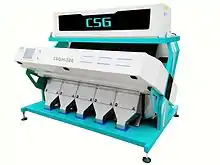Colour sorter
Colour sorters or color sorters (sometimes called optical sorters, digital sorters, or electronic colour sorters) are machines that are used on the production lines in bulk food processing and other industries. They separate items by their colours, detecting the colours of things that pass before them, and using mechanical or pneumatic ejection devices to divert items whose colours do not fall within the acceptable range or which are desired to form a separate group from the rest.[1][2]

Grain (agricultural products) industry
Color sorters are mostly used in sorting grain (agricultural products). The rice sorting industry is the first big market. The rice sorting technology is according to the color differences of rice (husked paddy) materials, using a high-resolution CCD optical sensor to separate stones, black rice, etc. It is the final step after polishing rice with a rice polisher. The second sorting market is in use for coarse cereals, such as wheat, corn, peanut, different kinds of beans, sesame seeds, etc. Sorting machines improve product quality and add social benefits.
Food industry
Colour sorters are used for the food processing industry, such as coffee, nuts, and oil crops. The goal is the separation of items that are discoloured, toxic (such as ergot), not as ripe as required, or still with hull after dehulling such as sunflower seeds.. Compared with manual sorting, machines save labor and time, have higher efficiency, and have lower processing costs. Throughputs have increased with the use of new CCD technologies and are now up to 100 t/h.
Diamond and mining industry
They are also used in the diamond industry. The transparency of the diamond is measured by the colour sorter and used as a measurement of its purity, and the diamonds are mechanically sorted accordingly. This has an advantage over X-ray fluorescence methods of robotically detecting purity, since purer diamonds are less likely to fluoresce.[3]
In thimining sorting industry, It is also called sensor-based sorting technology. Optical color sorters (CCD color camera) combine X-ray sorting technology and NIR (near infrared spectrometry) to pick out the impurities of ore, minerals, stone and sand products, or separate ore into two or more categories.
Recycling
In the recycling industry, colour sorters can distinguish between coloured and colourless PET and coloured and colourless HDPE flakes, as well as being able to separate flakes by colour before re-granulation.[4] Plastic colour separators are used to separate mixed-colour plastic flakes or granules. Plastic type separators (Sensor-based sorting technology) are used to separate plastics with same colours but different materials. The industry recognized technology is use a chute color sorter to sorting plastic pellets, and a belt-type color sorter to sort plastic flake products.[5]
Types
Sorters can be divided into chute-type and belt-type color sorters.
Belt-type color sorters break a smaller percentage of the material (important for nuts), and the product stays relatively static during the transport process as it moves horizontally on the belt. In the chute type, material slides on the chute because of gravity, causing collision, friction, and larger vertical movements, thus worsening the ratio of broken material. The belt structure makes the transmission smooth and stable without bouncing of material.
Chute-type color sorters are more common especially for food, as prices are lower, capacities are higher, and products can be seen more easily from both sides, which is important when a dehulled grain has hull only on one side. Chute sorters are usually applicable to specific products, as the chute is designed with special channels for this kind of material based on sizes and shapes of the material. For example, 5 mm chutes are used for rice, grain and plastic granules. Flat chutes are right for plastic flakes, such as PET, or milk bottle flakes.
References
- Somani 1989.
- Kumar 2008.
- Malhotra et al. 2009, p. 486.
- Scheirs 1998, p. 15.
- COLOR SORTER Machine Working Principle and Recycling Sorting Machine Type Guide. article source Aaron Hou, 2010 at China
6.Color sorter is being used in the nuts industry for grading nuts and seeds.
Sources
- Somani, L. L. (1989). "electronic colour sorter". Dictionary of plant sciences (including horticulture). Mittal Publications. ISBN 978-81-7099-130-4.CS1 maint: ref=harv (link)
- Kumar, Dinesh (2008). "electronic colour sorter (seed)". Definitional Glossary Of Agricultural Terms. 2. I. K. International Pvt Ltd. ISBN 978-81-906757-4-1.CS1 maint: ref=harv (link)
- Malhotra, Deepak; Taylor, Patrick R.; Spiller, Erik; LeVier, Marc (2009). "Other separation processes". Recent Advances in Mineral Processing Plant Design. SME. ISBN 978-0-87335-316-8.CS1 maint: ref=harv (link)
- Scheirs, John (1998). "Optical Sorting". Polymer recycling: science, technology, and applications. Wiley. ISBN 978-0-471-97054-5.CS1 maint: ref=harv (link)
Further reading
- Low, J.M.; Maughan, W.S.; Bee, S.C.; Honeywood, M.J. (2001). "Sorting by colour in the food industry". In Kress-Rogers, Erika; B. Brimelow, Christopher J. (eds.). Instrumentation and sensors for the food industry (2nd ed.). Woodhead Publishing. ISBN 978-1-85573-560-6.CS1 maint: ref=harv (link)
- Bee, S.C.; Honeywood, M.J. (2002). "Colour sorting for the bulk food industry". In MacDougall, Douglas B. (ed.). Colour in food: improving quality. Woodhead Publishing. ISBN 978-1-85573-590-3.CS1 maint: ref=harv (link)